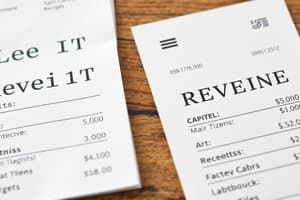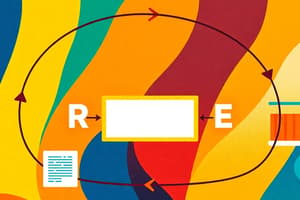Podcast
Questions and Answers
What is the objective concerning the occurrence of sales?
What is the objective concerning the occurrence of sales?
- Sales are allocated to the proper accounting period.
- All sales have been recorded.
- Recorded sales actually occurred and pertain to the entity. (correct)
- Sales are recorded at the correct amount.
Which assertion relates to the rights to trade receivables?
Which assertion relates to the rights to trade receivables?
- Valuation.
- Completeness.
- Existence.
- Rights. (correct)
What is a key condition for the recognition of revenue?
What is a key condition for the recognition of revenue?
- The obligation is not satisfied.
- The contract has commercial substance. (correct)
- It is probable that payment will not be collected.
- Payment terms cannot be identified.
Which of the following best defines the completeness objective for receipts?
Which of the following best defines the completeness objective for receipts?
What is the audit objective regarding the cut-off for sales?
What is the audit objective regarding the cut-off for sales?
What should be true regarding the accuracy of receipts?
What should be true regarding the accuracy of receipts?
What is an additional assertion for presentation and disclosure regarding the revenue cycle?
What is an additional assertion for presentation and disclosure regarding the revenue cycle?
Which assertion pertains to the valuation of trade receivables?
Which assertion pertains to the valuation of trade receivables?
What is the primary focus of the revenue phase in the revenue and receipts cycle?
What is the primary focus of the revenue phase in the revenue and receipts cycle?
Which function is NOT typically involved in the revenue and receipts cycle?
Which function is NOT typically involved in the revenue and receipts cycle?
At what level does the risk assessment for potential material misstatements primarily occur?
At what level does the risk assessment for potential material misstatements primarily occur?
What could be a method directors might use to manipulate profits?
What could be a method directors might use to manipulate profits?
What risk may arise concerning accounts receivable?
What risk may arise concerning accounts receivable?
Which aspect is included in assessing transaction-level risks?
Which aspect is included in assessing transaction-level risks?
What is one of the possible consequences of poor risk assessment procedures?
What is one of the possible consequences of poor risk assessment procedures?
When might sales invoices be raised improperly?
When might sales invoices be raised improperly?
What is the primary purpose of performing tests of controls?
What is the primary purpose of performing tests of controls?
Which of the following is NOT a type of substantive analytical procedure?
Which of the following is NOT a type of substantive analytical procedure?
What dictates the extent of substantive testing?
What dictates the extent of substantive testing?
Which audit procedure involves observing the actions of personnel?
Which audit procedure involves observing the actions of personnel?
When is it appropriate to perform tests of controls?
When is it appropriate to perform tests of controls?
What is a common example of a test of control procedure involving inquiry?
What is a common example of a test of control procedure involving inquiry?
What occurs when controls appear to be less effective?
What occurs when controls appear to be less effective?
Which of the following audit procedures involves inspecting documentation?
Which of the following audit procedures involves inspecting documentation?
What is the primary purpose of positive confirmation in debtor circularisation?
What is the primary purpose of positive confirmation in debtor circularisation?
What is a key characteristic of negative confirmation compared to positive confirmation?
What is a key characteristic of negative confirmation compared to positive confirmation?
When can a seller recognize revenue for layaway transactions under International Financial Reporting Standards?
When can a seller recognize revenue for layaway transactions under International Financial Reporting Standards?
Which assertion is primarily tested by the use of debtor circularisation procedures?
Which assertion is primarily tested by the use of debtor circularisation procedures?
What action does the auditor take with debtors' statements after they are printed?
What action does the auditor take with debtors' statements after they are printed?
What is the purpose of tracing recorded sales transactions back to the source?
What is the purpose of tracing recorded sales transactions back to the source?
Which procedure is used to confirm the accuracy of recorded sales amounts?
Which procedure is used to confirm the accuracy of recorded sales amounts?
What is the purpose of obtaining document numbers of the last invoices at year end?
What is the purpose of obtaining document numbers of the last invoices at year end?
What does existence testing of trade receivables primarily involve?
What does existence testing of trade receivables primarily involve?
Which document(s) might be inspected to confirm a company’s rights to trade receivables?
Which document(s) might be inspected to confirm a company’s rights to trade receivables?
Which of the following is NOT a substantive procedure for testing the accuracy of sales?
Which of the following is NOT a substantive procedure for testing the accuracy of sales?
When performing cut-off testing for sales, what is a key step?
When performing cut-off testing for sales, what is a key step?
What is meant by 'debtors circularization' in the context of existence testing?
What is meant by 'debtors circularization' in the context of existence testing?
Flashcards are hidden until you start studying
Study Notes
Revenue and Receipts Cycle Audit
- The revenue and receipts cycle audit focuses on sales and collection processes.
- The revenue phase involves making sales, while the receipts phase ensures payment for services or products.
- Sales can be made in various ways, including cash, credit, and installments, with payments made through cash, credit cards, or electronic transfers.
Revenue and Receipts Cycle Process
- The process involves receiving customer orders, approving credit, determining goods availability, delivering goods, invoicing customers, collecting cash, and recognizing the impact on other accounts.
Risk Assessment Procedures
- Auditors identify and assess risks of material misstatement at the financial statement, account balance, and transaction levels.
- At the financial statement level, there is a risk of manipulating sales to overstate or understate profits, potentially through fictitious sales with related parties.
- At the account balance level, an inadequate allowance for bad debts could overstate accounts receivables.
- At the transaction level, inadequate controls over cash sales or raising sales invoices before goods are picked from the warehouse present risks.
Audit Objectives
- The audit objective for sales transactions focuses on occurrence, accuracy, cut-off, completeness, and classification.
- Occurrence ensures that recorded sales actually occurred and relate to the entity, while accuracy verifies the sales amounts are correct.
- Cut-off ensures sales are allocated to the correct accounting period, completeness confirms all sales are recorded, and classification ensures sales are recorded in the appropriate accounts.
- The audit objective for receipts transactions focuses on occurrence, accuracy, cut-off, completeness, and classification.
- Occurrence ensures that recorded receipts were actually received for amounts owed to the entity, while accuracy verifies the receipts are recorded at the correct amount.
- Cut-off ensures receipts are allocated to the correct accounting period, completeness confirms all receipts are recorded, and classification ensures receipts are recorded in the appropriate accounts.
- The audit objective for receivables balances focuses on existence, rights, completeness, and valuation.
- Existence confirms that trade receivables actually existed at the reporting date, while rights ensure the company has a claim on the trade receivables.
- Completeness verifies that all trade receivables are included, while valuation ensures trade receivables are included at an appropriate carrying value.
Assertions Regarding Presentation and Disclosure
- The directors are also representing the completeness, classification, accuracy, and presentation of all matters regarding balances and transactions in this cycle.
Revenue Recognition
- A sale is recognized only when there is an approved contract to perform a specific obligation that is satisfied, with identifiable rights for each party under the contract.
- The payment terms and commercial substance of the contract are also considered, ensuring the probability of collecting payment.
Responses to Assessed Risks
- Risk Assessment Procedures are performed to understand the entity, and further audit procedures address the assessed risks.
- If controls are operating effectively, substantive tests are performed to detect material misstatements at the assertion level. Otherwise, test of controls procedures are performed to obtain evidence of the effectiveness of controls during the period.
Substantive Testing Audit Procedures
- Substantive testing is determined by the assessed risk of material misstatement and the effectiveness of controls.
- Increased risk and less effective controls typically require more substantive testing, reflected in the size of samples used for testing.
Laybuy Transactions
- Revenue is not recognized until goods are delivered, except when historical experience indicates most layaway transactions convert to sales.
- Revenue can be recognized when a significant deposit is received, provided goods are available for delivery.
Studying That Suits You
Use AI to generate personalized quizzes and flashcards to suit your learning preferences.




